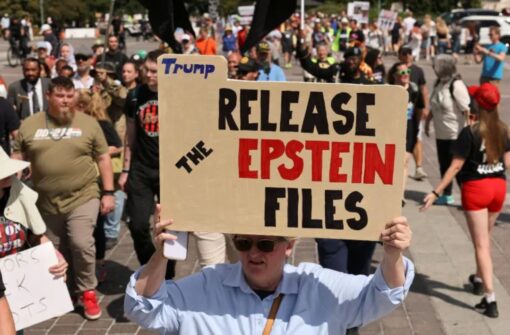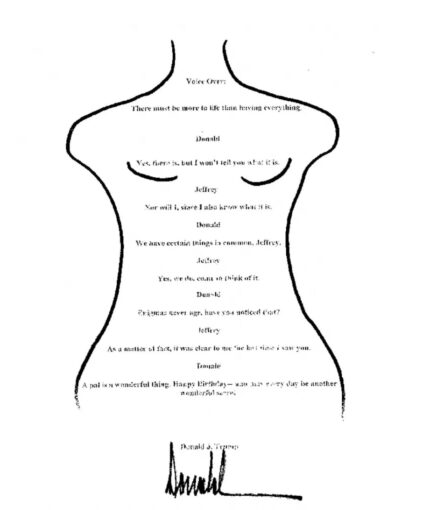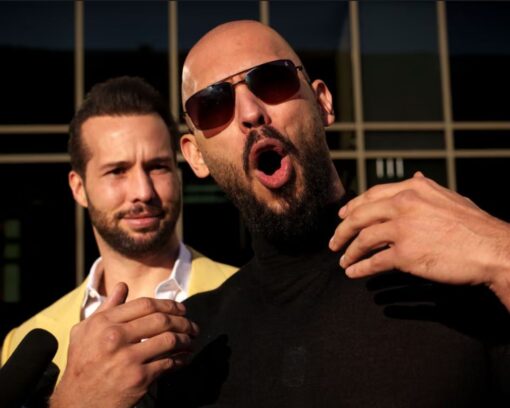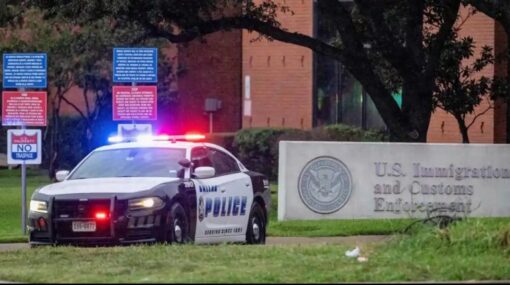The White House has moved to contain a growing political firestorm by signaling support for an independent handwriting analysis of a controversial note allegedly written by President Donald Trump to the late financier Jeffrey Epstein more than two decades ago.
The note, released by Democratic lawmakers earlier this month, has reignited public debate over Trump’s long-documented ties to Epstein and unleashed a fresh round of legal and political battles that threaten to overshadow the administration’s agenda.
At the heart of the controversy is a sexually suggestive birthday message, said to have been signed by Trump in 2003 inside a scrapbook marking Epstein’s 50th birthday.
The page in question, which features a naked female outline filled with text, includes what appears to be Trump’s distinctive signature beneath the inscription. The White House has categorically denied its authenticity, calling the document “fabricated political theater.”
Despite the president’s denials, the release of the note has spurred a wave of media coverage, protests, and new calls from survivors of Epstein’s abuse for greater transparency.

Trump’s political opponents argue the handwriting appears consistent with his well-known scrawl, while his allies insist the letter is either forged or digitally manipulated.
Why handwriting analysis matters
The Trump Epstein birthday note has quickly become a test case for the reliability of forensic handwriting analysis in the age of viral images and political disinformation. Experts in the field stress that determining authorship requires access to original documents, not copies or digital reproductions circulated online.
Handwriting analysts typically examine stroke pressure, letter proportions, slant, spacing, and the natural variation that occurs in genuine signatures. According to specialists, photocopies or screenshots obscure these details, leaving only surface-level comparisons that can be misleading.
“The human hand never produces two signatures that are perfectly identical,” explained one veteran examiner interviewed about the Trump handwriting analysis.
“That variability is what gives away simulations. But without the actual ink on paper, you cannot measure the speed, the pressure, or the flow of writing.”
For Trump, whose sharp, jagged signature has been widely reproduced on books, contracts, and presidential documents, the challenge is both political and forensic.
Supporters claim the unique nature of his penmanship makes it an easy target for skilled imitators. Critics counter that his signature’s flamboyant style makes it all the more recognizable—and harder to fake convincingly.
Political stakes for Trump
The uproar over the Trump Epstein birthday note comes at a precarious time for the president, who has spent much of the year fighting legal battles while campaigning to solidify his domestic and international influence.
Earlier this month, Trump filed a $15 billion defamation lawsuit against The New York Times over reporting related to the alleged note, accusing the paper of spreading “malicious fabrications.”
Republican strategists close to the White House argue that demanding a professional handwriting review is a savvy move to undercut Democratic claims. By supporting an independent analysis, Trump’s allies believe they can demonstrate transparency while shifting the burden of proof back onto critics.
“This is the president saying: put it under the microscope,” one GOP operative remarked. “If the experts can’t confirm it, then Democrats have been caught weaponizing a forgery. If they can, then at least it goes through a professional process instead of trial by Twitter.”
Democrats, meanwhile, insist the document speaks for itself. Members of the House Oversight Committee who released the scrapbook page argue that the president’s denials only highlight the need for further investigation into his past association with Epstein.
Survivors demand accountability
The Trump handwriting expert review has also intersected with renewed activism by survivors of Epstein’s abuse. Advocates say the controversy should not distract from broader questions about how Epstein’s powerful network shielded him for years from justice.

At a recent press conference in Washington, survivors called on Congress to release the remaining sealed files related to Epstein’s operations, including correspondence, visitor logs, and financial records. They criticized what they described as an “elite protection racket” that has kept key information hidden from the public.
“Every time a new document emerges, we see powerful men scrambling to deny or discredit it,” one survivor said. “What we want is full transparency. Not selective outrage, not political spin—just the truth.”
Experts divided on the note
Handwriting specialists consulted by various media outlets remain cautious. Several acknowledged that the signature in the scrapbook “falls within the range of variation” of Trump’s known handwriting, while others emphasized that no definitive conclusion can be reached without the original document.
Some analysts noted signs that the alleged Trump Epstein birthday note may have been replicated or traced, pointing to its unusually clean lines. Others observed that its shape and proportions strongly resemble Trump’s known autographs from the late 1990s and early 2000s.
“There are similarities, but similarities are not proof,” explained a U.S.-based examiner who declined to be named publicly. “If this is a copy, then any skilled penman could reproduce it convincingly enough to pass casual inspection. That’s why originals matter.”
Legal and historical context
Handwriting analysis has long played a role in high-profile legal cases, from disputed wills to criminal prosecutions. A 2022 peer-reviewed study found that trained forensic examiners made correct authorship determinations in the vast majority of cases, with error rates under 4 percent. However, the discipline remains vulnerable to public skepticism, particularly when deployed in politically charged contexts.
Trump’s legal team has sought to position the handwriting review as part of a broader narrative of media bias and Democratic overreach. In court filings, they argue that the note represents a deliberate attempt to smear the president by tying him more directly to Epstein.
Democratic leaders counter that the administration’s aggressive legal response only fuels suspicion. They have demanded the White House release any relevant archives and cooperate with congressional subpoenas related to Trump’s historical ties to Epstein.
International dimension
The Trump Epstein scandal has drawn global attention, not only because of Epstein’s notoriety but also because it touches on questions of elite impunity across borders. International media outlets have highlighted the controversy alongside renewed scrutiny of figures in Britain, France, and elsewhere who once moved in Epstein’s circles.
In the UK, the royal family remains under pressure following revelations about Epstein’s threats against Sarah Ferguson, the Duchess of York, years before her public apology. Analysts suggest the simultaneous focus on Trump and British royalty underscores how Epstein’s legacy continues to haunt global power structures.
What happens next?
If Trump’s team follows through, an independent handwriting analysis would likely involve multiple forensic experts examining the original scrapbook page under laboratory conditions.
Analysts would compare it against authenticated Trump signatures from the same era, taking into account the type of writing instrument used and any signs of forgery such as tremors or retouching.
The results would almost certainly be presented on a probability scale rather than as absolute proof, ranging from “highly probable” to “inconclusive.” Even then, experts caution that no analysis can fully erase doubts in a case so entangled with politics.
For Trump, the outcome could prove decisive in shaping public opinion. A finding that casts doubt on the authenticity of the Epstein birthday note would bolster his legal claims and deflate Democratic attacks. A finding consistent with his handwriting, even if not definitive, could deepen scrutiny of his past ties to Epstein and complicate his broader political strategy.
A scandal with staying power
What makes the Trump Epstein birthday note controversy so potent is not simply the question of authorship but what it symbolizes. For critics, it reinforces a narrative of powerful men entangled in Epstein’s shadowy world. For supporters, it illustrates how political opponents weaponize dubious evidence to damage Trump’s credibility.

Either way, the story shows little sign of fading. As survivors demand accountability, Congress escalates its investigations, and Trump wages courtroom battles, the note has become more than a single document—it is now a flashpoint in the struggle over truth, transparency, and political survival.
In the coming months, the results of any expert review will be closely watched. But even then, the deeper questions—about power, accountability, and the enduring scars of Epstein’s crimes—are unlikely to disappear.


